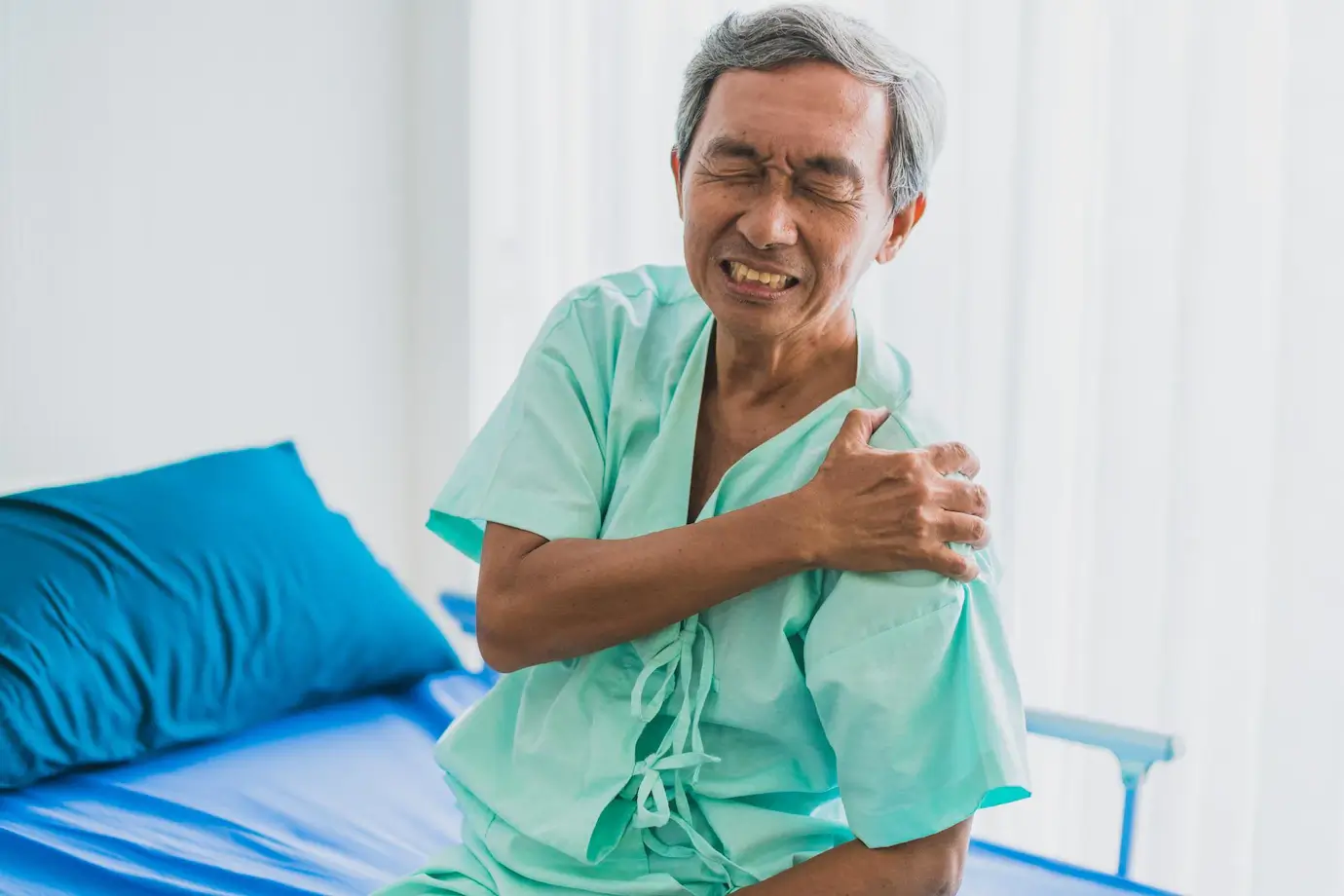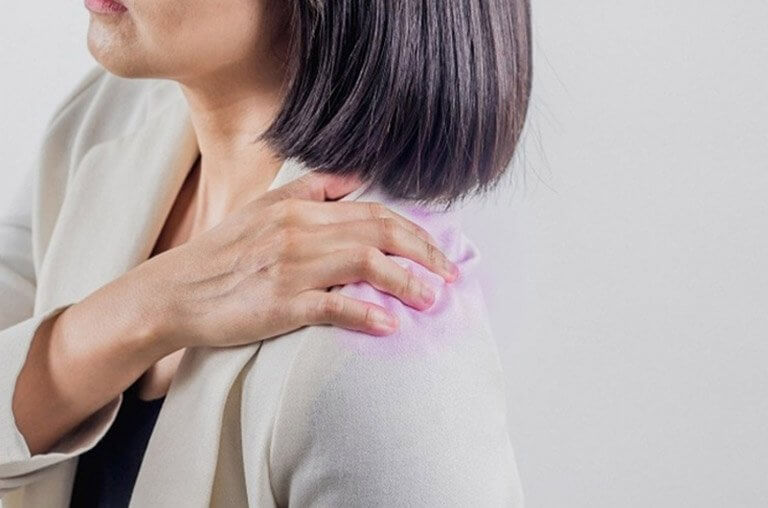Shoulder osteoarthritis is a typical joint and bone condition nowadays. It causes pain, stiffness, and reduced mobility in the shoulder and arm area. Early detection and timely treatment can slow down the progression of the disease. Let AMIO StemCell guide you through some common symptoms and effective treatment methods.
NỘI DUNG CHÍNH
What is Shoulder Osteoarthritis?
Shoulder osteoarthritis is the process of cartilage erosion leading to pain, stiffness, and joint rigidity. When the joint surface is affected by osteoarthritis, the underlying bone regenerates, and the joint capsule thickens, resulting in a loss of shoulder rotation capability. Additionally, the shoulder joint exhibits signs of inflammation, and synovial fluid levels decrease significantly.
Patients often experience pain and significant limitations in daily activities. Symptoms and the degree of shoulder joint inflammation, visible in X-rays, determine the treatment options. Patients must identify and seek timely treatment as the condition can lead to severe complications, such as shoulder joint calcification, neck paralysis, and joint deformities.

Causes of Shoulder Osteoarthritis
Several factors contribute to the development of shoulder osteoarthritis, including:
- Aging: Over time, joint health deteriorates, making the shoulder joint more susceptible to damage and osteoarthritis. After age 50, due to increased shoulder joint activity, cartilage erosion in this area often becomes more pronounced.
- Congenital Defects: Misalignment of bones with the body’s natural physiological structure can also increase the risk of shoulder joint dislocation, contributing to shoulder osteoarthritis.
- Gender: Gender can play a role in shoulder osteoarthritis, with a higher incidence in women, including shoulder joint involvement. Women, on average, have taller shoulder joints than men.
- Obesity: Although the shoulder doesn’t bear the body’s weight, excess weight can still affect shoulder health by promoting systemic inflammation, creating conditions conducive to shoulder osteoarthritis development.
- Genetics: In some cases, shoulder osteoarthritis has a genetic component. Research suggests that individuals with a family history of the condition may be more prone to developing it, particularly from their mothers’ side.

Recognizing the Symptoms of ShoTheritis
The disease may silently progress for months or even years before apparent symptoms manifest. During the early stages, patients often attribute sudden bouts of pain to personal habits, such as inactivity and Temporary fatigue. It can delay diagnosis and treatment.
Therefore, when any abnormal signs in the shoulder joint area arise, it’s essential to consult an orthopedic physician promptly for examination and timely treatment.

- Shoulder Pain: Unlike muscle soreness, shoulder pain occurs deep inside and persists regardless of movement or rest. Pain is often felt at the normal range of motion.
- Joint Stiffness: Another sign of shoulder osteoarthritis is joint stiffness, typically accompanied by a reduced range of motion. Even with assistance, patients may struggle to perform specific movements.
- Audible Crepitus: As the shoulder joint’s cartilage wears down, it exposes bone surfaces, resulting in characteristic creaking or popping sounds when moving the shoulder.
- Swelling and Redness: Friction between bone surfaces can stimulate inflammation, affecting the surrounding soft tissues and causing localized swelling. However, shoulder inflammation may not be as pronounced as cases involving knees or hands.

Effective Treatment for Shoulder Osteoarthritis?
Shoulder osteoarthritis is a chronic condition that cannot be cured entirely. However, various treatment options are available with the advancement of medical science. The treatment approach will be tailored to each patient’s specific situation. Generally, treatment options include:
- Injection Therapy: Local steroid injections can rapidly reduce pain and inflammation, while hyaluronic acid injections provide joint lubrication.
- Physical Therapy: Physical therapy includes strengthening the supporting muscles around the shoulder joint, alleviating pain and stiffness, and improving joint mobility.
- Bio Nano Cell – Stem Cell Therapy: At AMIO, Bio Nano Cell – Stem Cell Therapy is the most sought-after method for caring for and protecting joints. This treatment mechanism involves the automatic search, repair, and complete replacement of damaged cells caused by aging, creating healthier cells to support and treat the condition.

BIO NANO CELL – Pluripotent cell therapy
This therapy has received high praise from experts and has successfully helped millions of customers due to its outstanding effectiveness:
– Stimulating cell replication and enhancing collagen development to regenerate lubrication for improved joint mobility.
– Balancing the growth of fiber and muscle cells, thus regulating the firmness and elasticity of joint cartilage.
– Promoting the growth of nourishing blood vessels for joint cartilage.
– Improving mobility, enhancing joint durability, and flexibility.
AMIO STEMCELL – INTERNATIONAL REGENERATIVE MEDICINE INSTITUTE
☎ Hotline: 1900 5656 00
🏢256 Nam Kỳ Khởi Nghĩa, Phường Võ Thị Sáu, Quận 3, TPHCM
🌐Website: https://amiostemcell.vn/



Bài viết liên quan
Inflammation Around the Shoulder Joint – A Dangerous Yet Lesser-Known Condition
Inflammation around the shoulder joint with stiffness, also known as adhesive capsulitis or frozen shoulder, is a condition where the shoulder joint becomes stiff due to the formation of scar tissue around it. It thickens and tightens the joint capsule,...
Oct
Achilles Tendonitis – A Common Condition Among Athletes
Achilles tendonitis is a prevalent condition often encountered by athletes or professional sports enthusiasts. Patients typically experience prolonged and challenging discomfort that hampers their daily activities. If not promptly treated, it can lead to various dangerous complications. NỘI DUNG CHÍNH1....
Oct
Exploring Ankle Joint Inflammation with Experts
Ankle joint inflammation, known as ankle arthritis, is characterized by frequent pain, swelling, and stiffness in the ankle joint, especially after walking. Early diagnosis and treatment are crucial to manage symptoms and prevent associated risks. Approximately 90% of ankle arthritis...
Oct